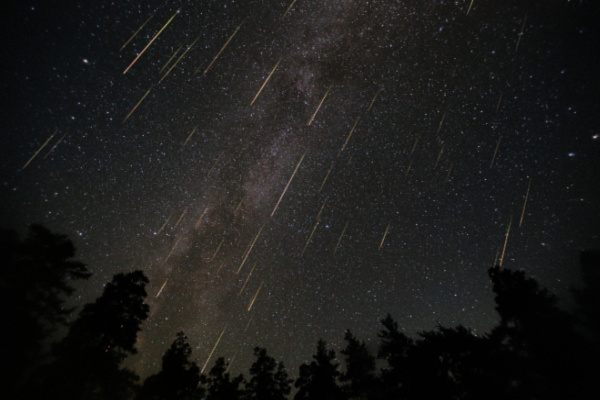Every year, 2 meteor showers – the famous Perseids and the lesser known Delta Aquariids – converge in late summer. Both have already started. The Delta Aquariids always peak in late July, but – in the week beginning July 24 – the moon sets between midnight and dawn, leaving some moon-free hours before dawn for watching for both Delta Aquariids and Perseids.
Here are EarthSky‘s tips on how to watch the night skies….
What is the duration of shower?
The meteors are visible from July 18 to August 21.
When is the nearest Moon Phase?
In 2023, the full moon falls at 18:32 UTC on August 1. Take advantage of the moon-free mornings in late July for watching the Delta Aquariids (and early Perseids).
When is the Radiant?
Rises in mid-evening, highest around 2 a.m. your local time (the time across the whole globe) and low in the sky by dawn. See chart below.
How do you tell the Aquariids and Perseids apart?
Perseid and Delta Aquariid meteors fly in our skies at the same time of year. How can you tell them apart? This is where the concept of a radiant point comes in handy. If you trace all the Delta Aquariid meteors backward, they appear to radiate from a certain point in front of the constellation Aquarius, which, as viewed from the Northern Hemisphere, arcs across the southern sky.
Meanwhile, the Perseids radiate from the constellation Perseus, in the northeast to high in the north between midnight and dawn as seen in Northern Hemisphere skies.
So – assuming you’re in the Northern Hemisphere, and watching around midnight or after – if you’re watching the Perseids and you see meteors coming from the northeast or north … they are Perseids. If you see them coming from the south … they are Delta Aquariids. In a particularly rich year for meteors, if you have a dark sky, you might even see them cross paths! It’s an awesome display!
When is the peak?
Meteor shower peak predicts vary. For example, there’s a predicted** peak for 18 UTC on July 30, 2023. But the Delta Aquariid shower doesn’t have a noticeable peak. It rambles along steadily from late July through early August, joining forces with the August Perseids. In fact, Delta Aquariid meteors fly for weeks!
The Delta Aquariids’ maximum hourly rate can reach 15 to 20 meteors in a dark sky with no moon. You’ll typically see plenty of Delta Aquariids mixed in with the Perseids, if you’re watching in early August.
Ideal Viewing Conditions:
The shower can be excellent from latitudes like those in the southern U.S. But July’s Delta Aquariid shower favors the Southern Hemisphere. And skywatchers at high northern latitudes tend to discount it. Delta Aquariid meteors tend to be fainter than Perseid meteors. So a moon-free dark sky is essential. About 5% to 10% of the Delta Aquariid meteors leave persistent trains, glowing ionized gas trails that last a second or two after the meteor has passed.
Bottom line:
The peak of the Delta Aquariid meteor shower is late July. But the shower rambles along steadily in late July and August, intermingling with the Perseids. In 2023, watch in late July to avoid moonlight.
—
Photo Credit: Makarov Konstantin / Shutterstock.com
